RECOIL OFFGRID Transportation Mil Spec Overland: Comforts of an RV on an LMTV
In This Article
Mil-spec is a term that’s often used by marketing copy writers to imply extreme toughness, but those who served in the military understand there’s another side to that term. While it’s true that Mil-spec products are thoroughly tested and held to precise standards, they’re also built to meet (not necessarily exceed) those standards while staying under a tightly controlled budget. More importantly, Mil-spec equipment is made to be used and maintained within a military supply chain. For civilian owners who don’t have access to specially trained service techs and warehouses full of spare parts, that can pose a significant challenge. However, there is a work around for those interested it acquiring a mil spec overland vehicle.
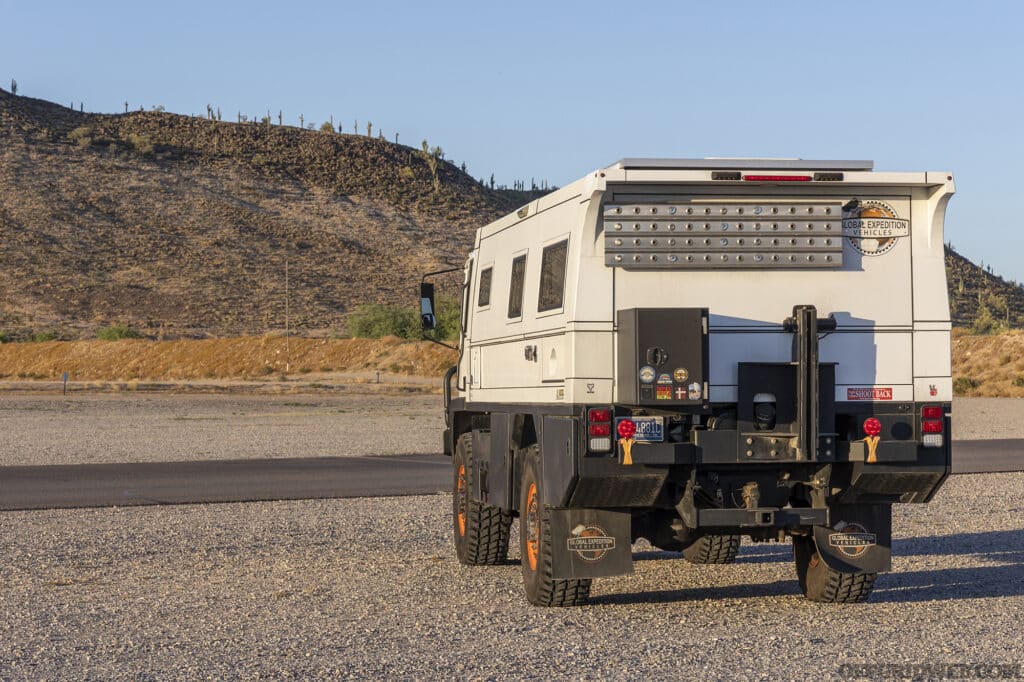
Above: The rear of the Pangea-LT features a mounting point for a full-size spare wheel (not currently installed) as well as a trailer hitch John uses to attach a carrier for his dirt bike.
The Family of Medium Tactical Vehicles (FMTV) is a series of U.S. Military vehicles loosely based on the 12M18 military truck originally built by Steyr-Daimler-Puch in Austria (a branch of the same Steyr that developed the AUG rifle). The FMTV includes more than a dozen variants designed to carry anything from troops and cargo to cranes, mobile command centers, and HIMARS rocket launchers. Most variants use a 5-ton, 6×6 chassis known as the MTV, but a few were developed on the 2.5-ton, 4×4 Light MTV chassis. With a base curb weight of roughly 23,000 pounds, the LMTV is only “light” in a comparative sense.
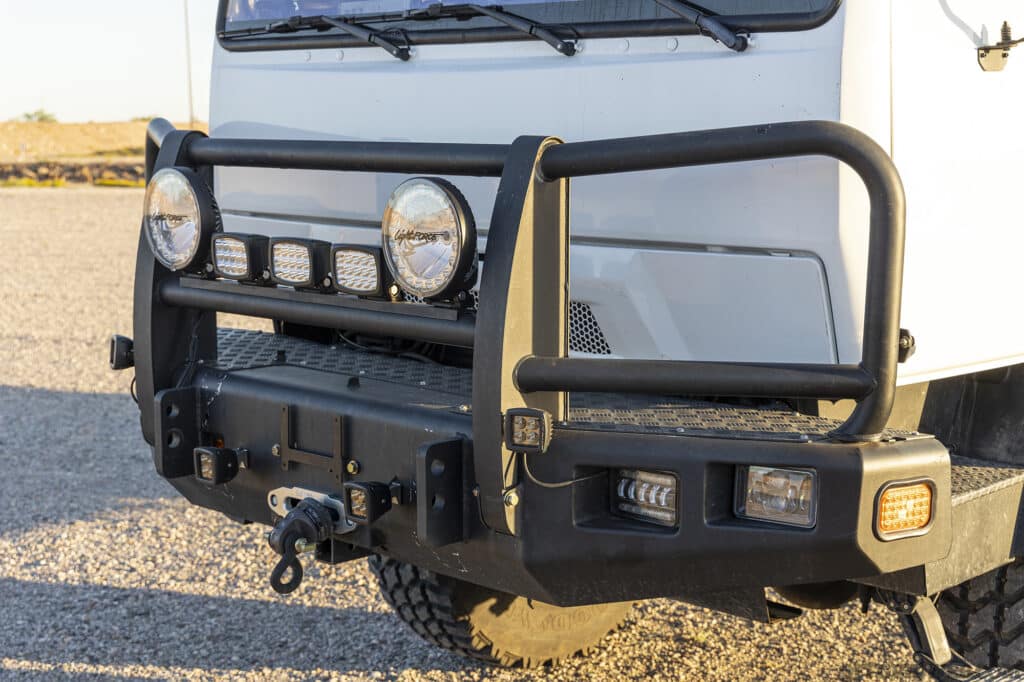
Above: In addition to the headlights recessed into the bumper, this truck has been upgraded with nine auxiliary LightForce LED lights — both visible and infrared.
This particular M1078 LMTV was built by BAE Systems, one of three contractors who manufactured the FMTV for the government. It features all the standard underpinnings: a Caterpillar C7 7.2-liter turbodiesel engine, Allison seven-speed transmission, integral single-speed transfer case, Meritor axles, and 47-inch off-road tires with a central inflation system. Technically, the LMTV is all-wheel drive, since its four wheels are powered with a 30/70 front-to-rear torque split at all times. A secondary off-road mode can be selected to split power 50/50 and enable the transmission’s low first gear for more technical terrain.
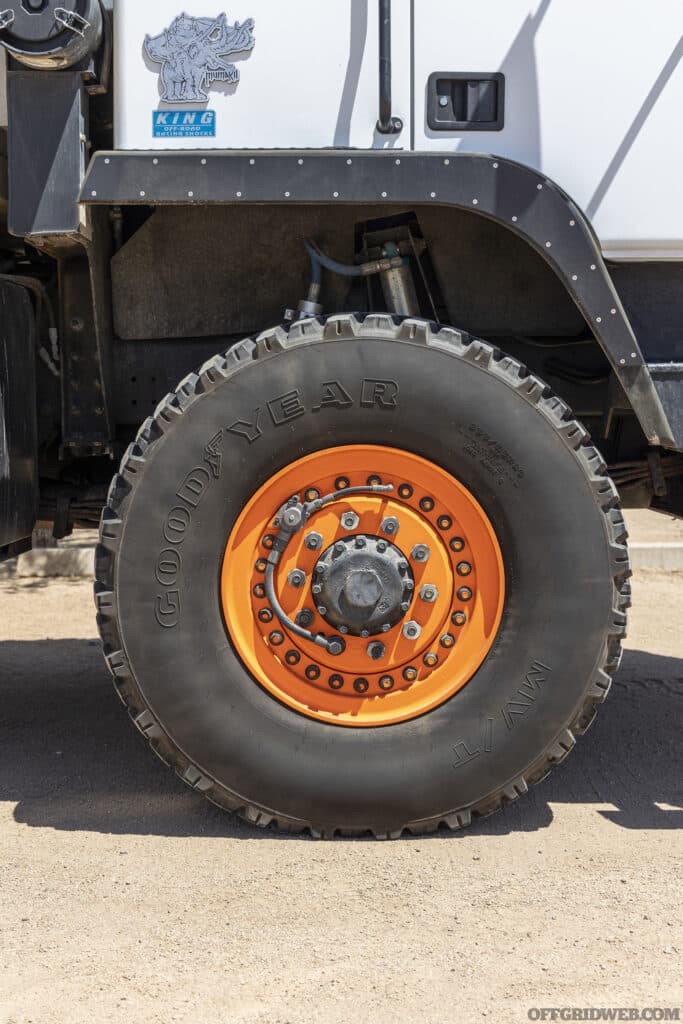
Above: Each aluminum beadlock wheel features a central tire inflation system that allows tire pressures to be adjusted on the fly. In the case of a minor puncture, the system can maintain pressure until the tire can be replaced.
Although many LMTVs make their way onto auction sites as military surplus, this build started life as a brand-new chassis with zero miles on the odometer. It was purchased from BAE Systems by Global Expedition Vehicles (GXV), who installed a custom 17-foot-long, lifting-roof RV cabin. The resulting 26-foot-long vehicle is called the GXV Pangea-LT and cost approximately $450,000. The drivetrain is mostly unmodified, aside from a tune that boosts engine output from 275 horsepower to 350 and new final drive gearing that increases top speed from 58 miles per hour to a more reasonable 75.
The owner of this Pangea-LT prefers to remain anonymous, so we’ll call him John. John purchased the truck in 2018, after cross-shopping EarthRoamers and realizing he wanted a chassis that was more rugged and off-road capable than a commercial Ford F-550. The LMTV certainly fit that requirement, and he also appreciated the maneuverability of its cab-over-engine configuration. The massive tires provide plenty of clearance and grip for expeditions off the beaten path, and there’s more than enough space for all his hunting, fishing, and backpacking gear.
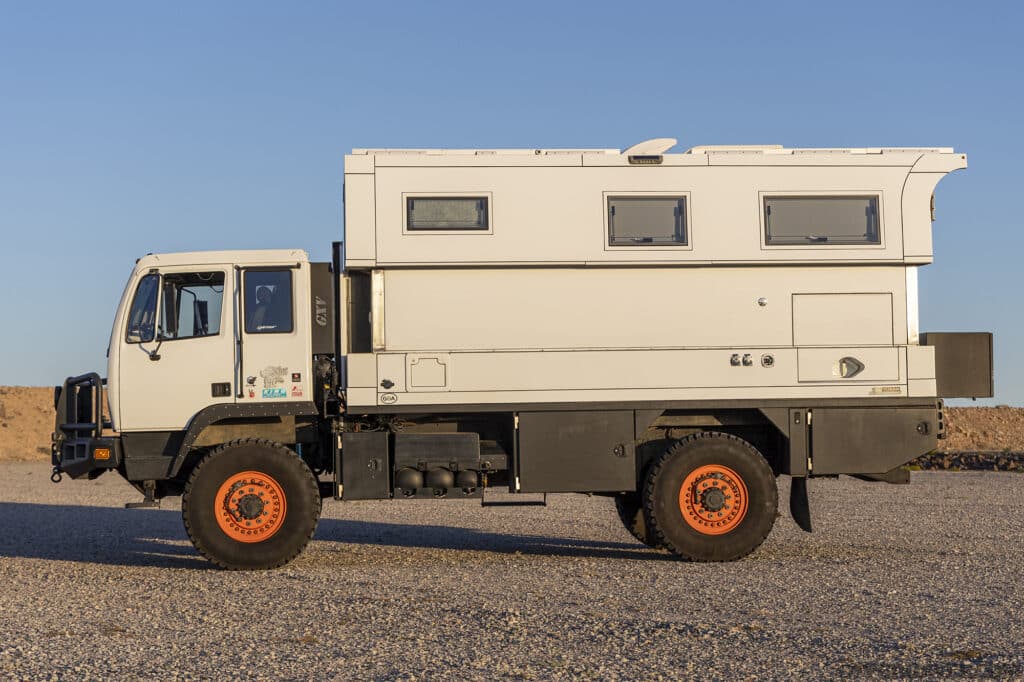
Above: Hydraulic lifters take only 20 seconds to raise the roof on the 17-foot GXV cabin.
Accessing the cabin is as simple as parking the truck and pressing a button to lift the hydraulic roof — the whole process takes only 20 seconds. The primary entry point is its passenger-side door, which features electric steps, but there’s also a small pass-through hatch that allows direct access from the cab. Inside, you’ll find a full-size bed, a two-person dining area that converts into a second bed, and a wet bath with shower and toilet. Appliances include almost everything you’d expect at home: a stainless two-drawer fridge/freezer, induction cooktop, microwave, and an LED TV. It has an air conditioner for warm days and a heater for cold nights; screened double-pane glass windows and a skylight let in fresh air.
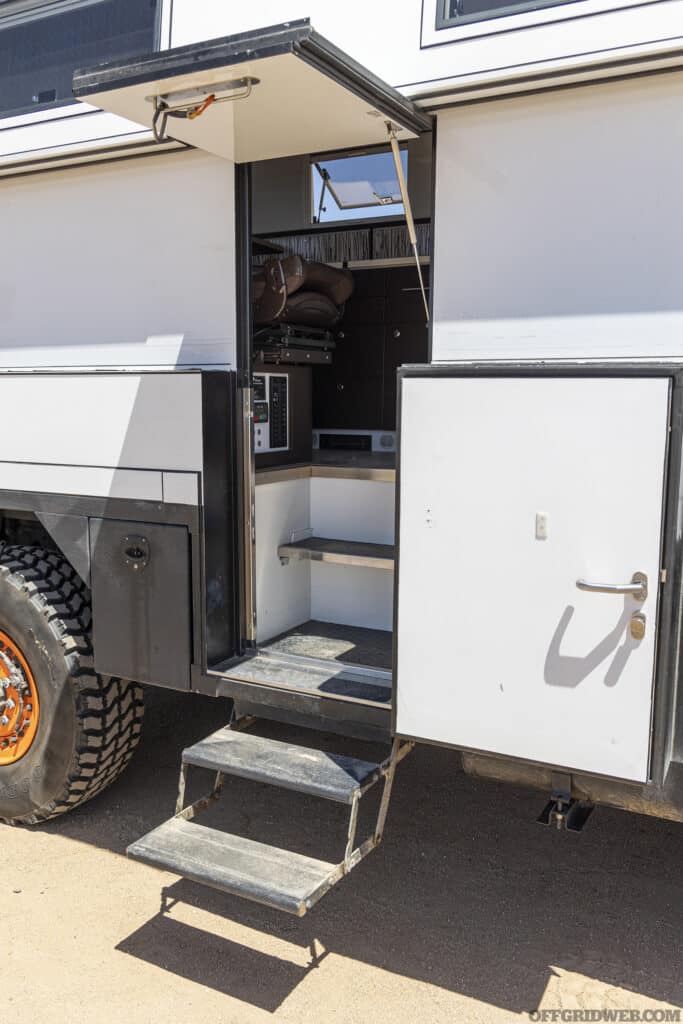
Above: Electric steps drop down to allow entry into the two-piece cabin door.
In the pass-through storage compartment at the rear, you’ll find the systems that keep the truck off-grid capable. A Mastervolt marine-grade electrical system keeps the 1,600-amp-hour batteries charged from an array of 300-watt solar panels on the roof. In rare cases where solar isn’t sufficient, a small diesel generator can be used to recharge the batteries, but John says he has only had to use it a handful of times.
Over the years, John has added a few upgrades to the LMTV. The front shocks were replaced with King remote-reservoir units for a smoother ride on washboard roads, and the original steel wheels and Michelin tires (which weigh 400 pounds each) were swapped for lighter MRAP aluminum wheels clad in Goodyear tires. The front bumper is outfitted with a heavy-duty winch and auxiliary lights from LightForce — both visible white and infrared for driving under night vision.
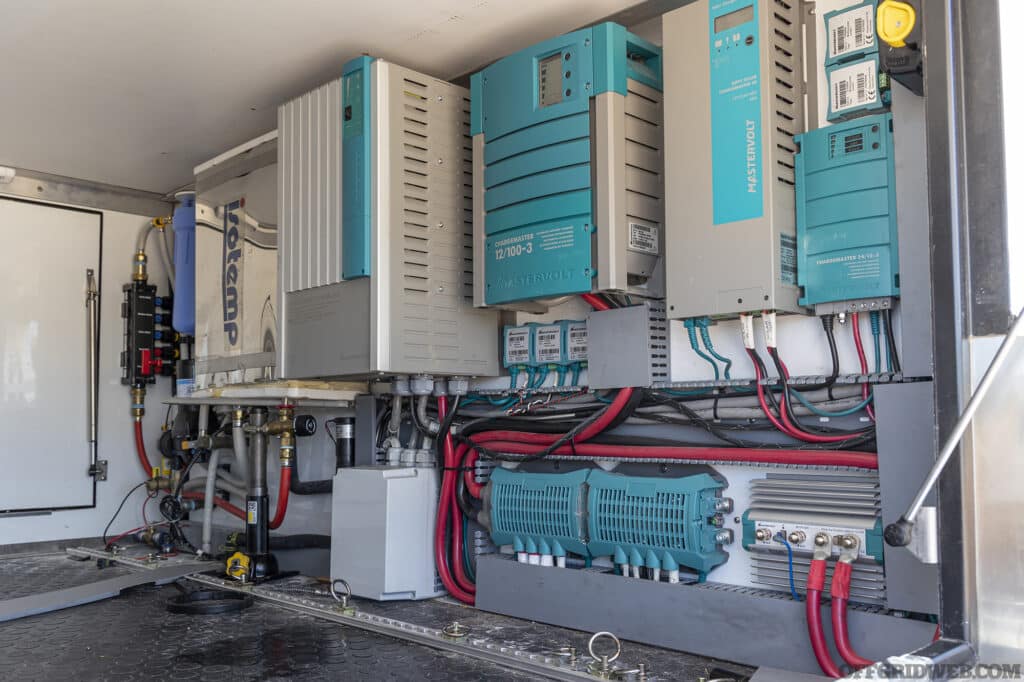
Above: A view of the onboard battery and electronic components.
Remember how we mentioned the challenges of owning a Mil-spec vehicle outside the military supply chain? John will be the first to tell you those challenges are very real. Due to its sheer size and weight, his LMTV averages around 6 to 7 miles per gallon. Even a simple oil change takes 7 gallons of oil, and leaks should be expected. Swapping a tire requires a heavy-duty jack and power tools to overcome the 475 lb-ft lug nut torque. John says tire changes are frequent, since the only tires available are aging military surplus. In five years of ownership, he has gone through three Michelins and two Goodyears. Unlike the single-battery 12-volt system in regular cars, the LMTV uses a 24-volt electrical system with four batteries, and John says parasitic drain is a fact of life for this vehicle. If you expect the engine to start after more than a few days, you’ll need to cut off power when you park.
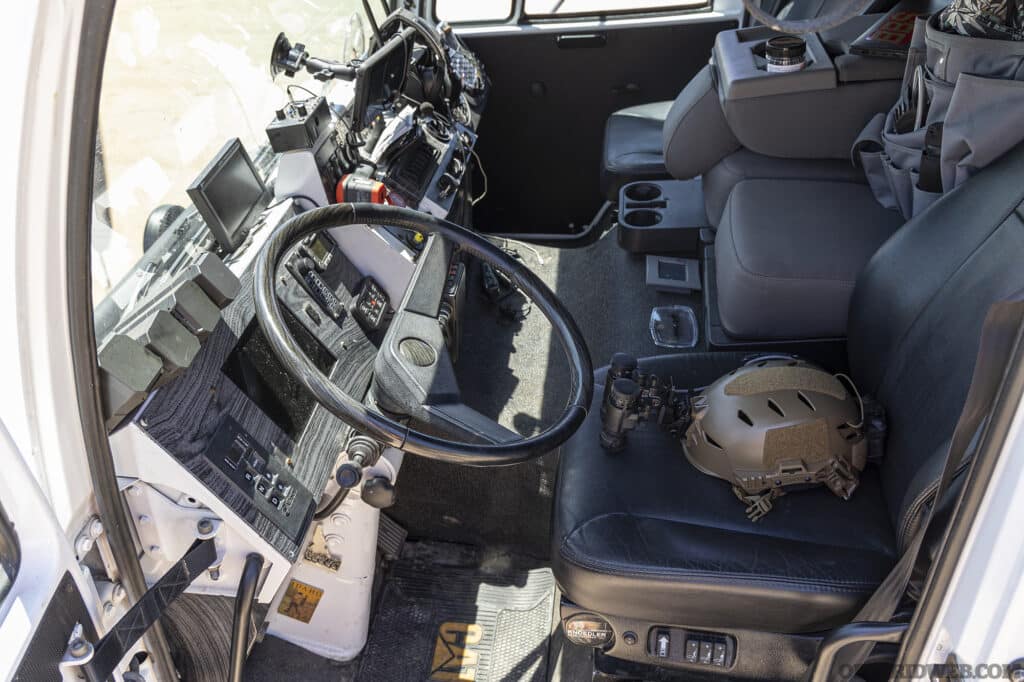
Above: The inside of the mil spec LMTV cab.
All of those issues fall under what most people would call basic maintenance. For any serious repairs, you’d better have a lot of patience and deep pockets. Since the Caterpillar and Allison drivetrain isn’t uncommon, most diesel truck shops can be convinced to work on the LMTV, but John says they charge a premium for this unusual platform — “expect them to turn up prices on everything by 50 percent.” Some parts, such as those for the cab and axles, may only be available through surplus auctions. And even though some people would expect a Mil-spec truck to be reliable, this one hasn’t been. John says the brakes started dragging while the truck was in motion, leading to a hefty repair bill. Driving on a heavily rutted trail caused the rear shock mounts to snap, so he had a fabricator build better mounts. Most recently, the turbo blew on a cross-country road trip.
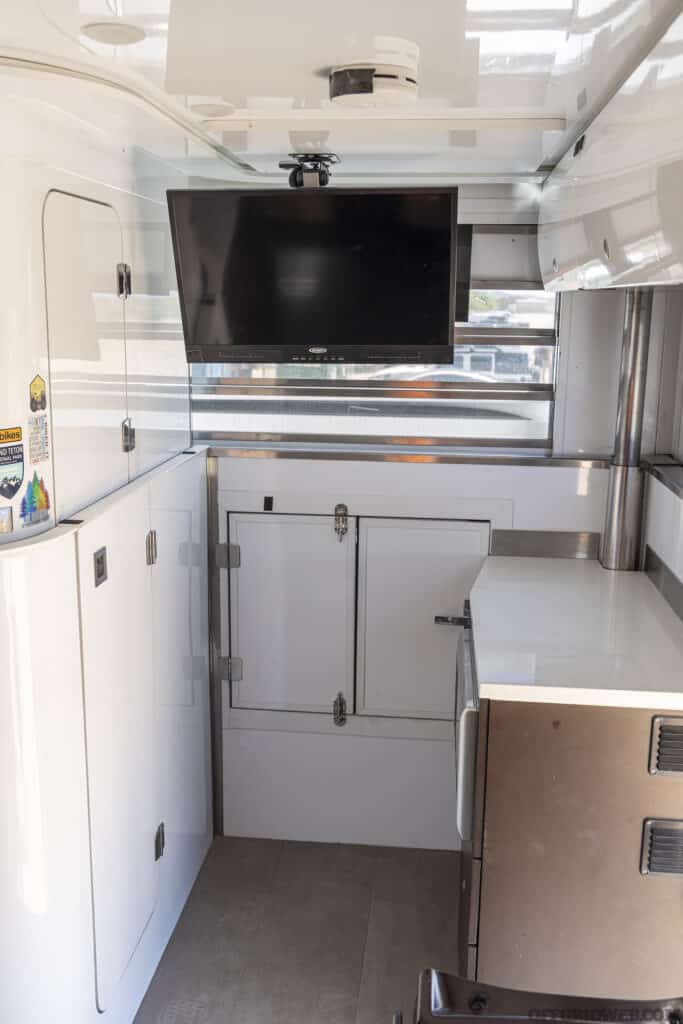
If you manage to get stuck in an LMTV, recovery is another challenge. Most ordinary trucks won’t be able to budge it with a tow strap, it’ll shatter plastic traction boards, and it’ll snap a Hi-Lift jack like a twig. John relies on the front winch, solid steel traction boards, and a set of Kevlar-reinforced air lifting bags when he takes the truck off-road.
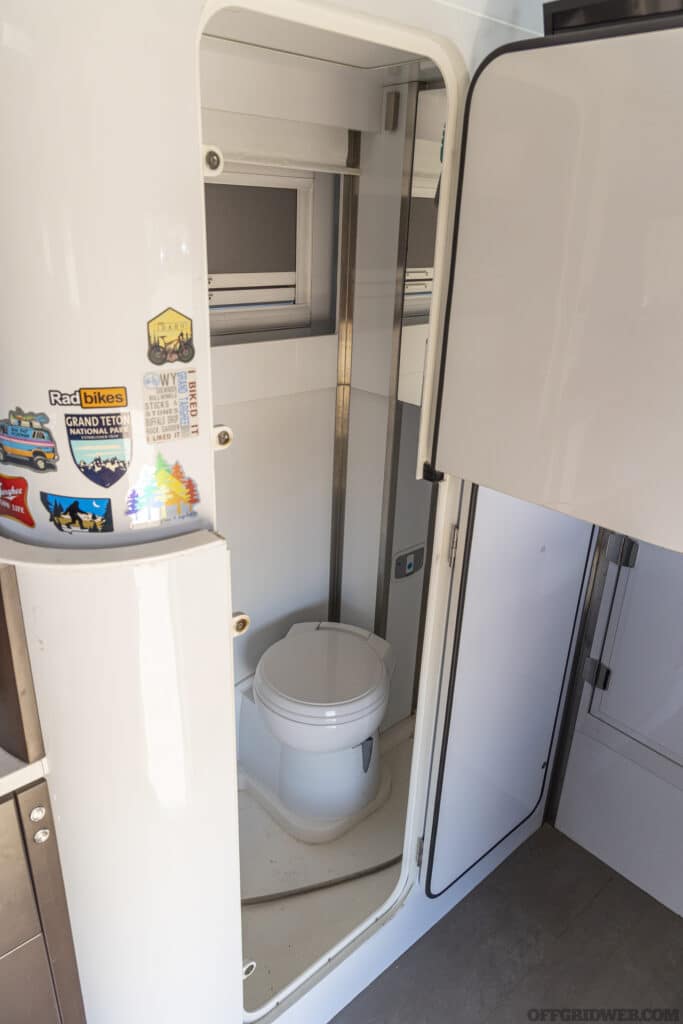
Despite all the challenges, John has enjoyed many adventures behind the wheel of his Pangea-LT. He frequently takes it on camping trips in Yellowstone National Park, goes fishing deep in the North Fork area of Montana, and heads out for shorter weekend trips closer to home. If he could do it all over again, he says he’d look harder at a Dodge or Ford chassis with a warranty. Even though those trucks don’t have as much off-road capability as an LMTV, they’d be substantially easier to repair and maintain.
Chassis: 2.5-ton 4×4 BAE LMTV Cargo (M1078)
Engine: CAT C7 7.2L six-cylinder turbo-diesel tuned to 350 hp

Transmission: Allison 3700 seven-speed automatic with single-speed transfer case, 3.07 final drive
Suspension: King remote-reservoir front shocks, custom-fabricated rear shock mounts
Wheels & Tires: 20-inch aluminum MRAP wheels, 47-inch Goodyear MV/T tires with Central Tire Inflation System (CTIS)
Camper: 17-foot GXV Lifting-Roof Cabin with pass-through rear storage compartment
Electronics: Mastervolt marine-grade electrical system with 1,600Ah battery capacity and six 300-watt solar panels, diesel backup generator
Interior Features: Full-size bed, two-person dining area, shower, cassette toilet, stainless steel sink, fridge/freezer, microwave, induction cooktop, LCD TV, heater, and A/C
URL: globalxvehicles.com
 STAY SAFE: Download a Free copy of the OFFGRID Outbreak Issue
STAY SAFE: Download a Free copy of the OFFGRID Outbreak Issue
No Comments